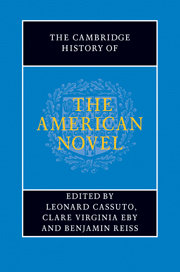Book contents
- Frontmatter
- General Introduction
- PART ONE INVENTING THE AMERICAN NOVEL
- Introduction: inventing the American novel
- 1 Transatlantic currents and the invention of the American novel
- 2 Susanna Rowson, Hannah Webster Foster, and the seduction novel in the early US
- 3 Charles Brockden Brown and the novels of the early republic
- 4 The novel in the antebellum book market
- 5 American land, American landscape, American novels
- 6 Cooper and the idea of the Indian
- 7 The nineteenth-century historical novel
- 8 Hawthorne and the aesthetics of American romance
- 9 Melville and the novel of the sea
- 10 Religion and the nineteenth-century American novel
- 11 Manhood and the early American novel
- 12 Sentimentalism
- 13 Supernatural novels
- 14 Imagining the South
- 15 Stowe, race, and the antebellum American novel
- 16 The early African American novel
- PART TWO REALISM, PROTEST, ACCOMMODATION
- PART THREE MODERNISM AND BEYOND
- PART FOUR CONTEMPORARY FORMATIONS
- A selected bibliography
- Index
8 - Hawthorne and the aesthetics of American romance
from PART ONE - INVENTING THE AMERICAN NOVEL
Published online by Cambridge University Press: 28 July 2011
- Frontmatter
- General Introduction
- PART ONE INVENTING THE AMERICAN NOVEL
- Introduction: inventing the American novel
- 1 Transatlantic currents and the invention of the American novel
- 2 Susanna Rowson, Hannah Webster Foster, and the seduction novel in the early US
- 3 Charles Brockden Brown and the novels of the early republic
- 4 The novel in the antebellum book market
- 5 American land, American landscape, American novels
- 6 Cooper and the idea of the Indian
- 7 The nineteenth-century historical novel
- 8 Hawthorne and the aesthetics of American romance
- 9 Melville and the novel of the sea
- 10 Religion and the nineteenth-century American novel
- 11 Manhood and the early American novel
- 12 Sentimentalism
- 13 Supernatural novels
- 14 Imagining the South
- 15 Stowe, race, and the antebellum American novel
- 16 The early African American novel
- PART TWO REALISM, PROTEST, ACCOMMODATION
- PART THREE MODERNISM AND BEYOND
- PART FOUR CONTEMPORARY FORMATIONS
- A selected bibliography
- Index
Summary
Nathaniel Hawthorne called his long narratives “romances” to claim their difference from the novels of his day. He appealed to a familiar and conventional distinction in order to launch a radical innovation. Romance in European culture, after its medieval dominance, had been killed by Cervantes in Don Quixote (1605) and its revival, in quite different form, two centuries later gave a name to the Romantics. In Britain, Walter Scott's historical romance in prose, beginning with Waverley (1814), offered a new freedom of action-packed storytelling, while the romanticism of William Wordsworth and Samuel Taylor Coleridge in the poems of Lyrical Ballads (1798) opened a path into the human mind. Hawthorne adopted the term used for the externally oriented works of Scott and his American counterpart James Fenimore Cooper, but he sought inwardness, the “truth of the human heart”.
Romance gave Hawthorne resources to establish an independent imaginative space, to gain for his works freedom from compromising involvement with his personal political commitments as a Democratic party loyalist or with larger, national controversies over slavery. It defined the space of fictionality from which American literary narrative arose. Romance was the term by which American prose narrative first began to take over cultural authority from poetry, on the way to a new definition of literature.
In the early twenty-.first century, what American bookstores sell on the “Literature” shelves is serious fiction, that is, the kind that highbrow culture validates. This is the mode Hawthorne invented for the United States, in his extended works from The Scarlet Letter (1850) through The House of the Seven Gables (1851), The Blithedale Romance (1852), and The Marble Faun (1860).
- Type
- Chapter
- Information
- The Cambridge History of the American Novel , pp. 135 - 150Publisher: Cambridge University PressPrint publication year: 2011
- 2
- Cited by



